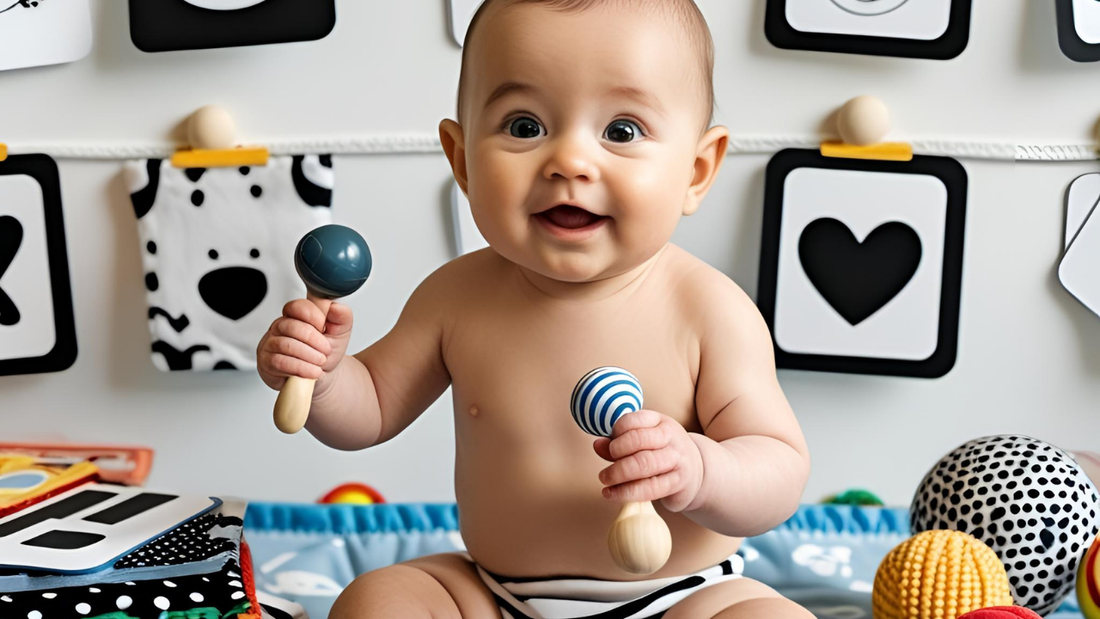
How Sensory Toys Help in Baby's Development: More Than Just Play
LiLLBUDBabies are born explorers-curious, wide-eyed, and ready to experience the world one texture, sound, and color at a time. But here's the secret most people don’t realize: every little shake, squish, crinkle, or splash is actually helping build your baby’s brain.
Sensory toys can assist with that. They are developmental treasures in addition to being adorable and vibrant. They are not merely for entertainment, they are made to stimulate sight, touch, sound, and even movement. They help infants learn about the world and themselves, one sense at a time.
Let’s dive into how sensory toys support your baby’s growth from head to toe, and sense by sense.
1. Visual Stimulation: Building Focus & Tracking
Babies are only able to see high contrasting patterns in the early months of life. Boldly designed sensory toys, such as black and white flashcards, help babies focus their gaze and promote visual tracking.
As their vision develops, bright, multi-colored toys help them distinguish colors and shapes, which lays the foundation for cognitive skills like sorting and matching.
Try: High-contrast cards, colorful rattles, spinning toys, or visual mobiles
2. Tactile Play: Exploring Through Touch
From squishy balls to bumpy textures, sensory toys based on touch introduce babies to size, texture, pressure, and temperature. These activities build fine motor skills, hand strength, and sensory awareness.
When babies grab a soft cloth or feel the coolness of a wooden ring, they’re not just being cute-they’re learning about the physical properties of their environment.
Try: Sensory boards, silicone teethers, soft fabric books, textured balls
3. Auditory Stimulation: Sound Meets Surprise
Rattling, jingling, crinkling, or squeaking toys stimulate a baby's sense of hearing and auditory abilities. Repeated sounds instruct cause and effect (shake = sound!), and musical toys engage rhythm, memory, and even early language development.
Bonus? Sound toys also help babies learn to filter and focus on certain noises-an important pre-skill for comprehending words in noisy settings.
Try: Shakers, musical plushies, crinkle toys, or simple xylophones
4. Cognitive Development: Learning Through Exploration
Sensory toys encourage babies to discover with all their senses-and that discovery develops brain connections.
When a baby touches something new, hears a sound, and watches it move, their brain is working overtime to connect that information. This multi-sensory learning is beneficial for memory, attention, problem-solving, and even emotional regulation.
Try: Cause-and-effect toys (like pop-up animals), shape sorters, or activity cubes
5. Motor Skills: From Grasping to Crawling
The purpose of many sensory toys is to promote movement, such as reaching, grabbing, pushing, rolling, or crawling after an object. Both fine motor (hand and finger) and gross motor (large body) skills are supported by these motions.
Additionally, babies develop coordination and body awareness when they learn to intentionally control their movements rather than thrashing around aimlessly.
Try: Rolling rattles, push-and-go cars, stacking cups, or sensory crawl mats
6. Emotional Development: Comfort, Curiosity & Confidence
Believe it or not, sensory toys can also support emotional growth. Familiar textures, soothing lights, and soft sounds help babies self-soothe and regulate emotions. In the meantime, experimenting with new feelings fosters curiosity and confidence, two qualities that promote safe, lifetime learning.
Try: Sensory bottles, cuddle toys with heartbeat sounds, or light-up plushies
What Makes a Good Sensory Toy?
When choosing a sensory toy for your baby, look for:
-
Age-appropriateness (safety first!)
-
Multiple textures and materials
-
Interactive elements (buttons, mirrors, flaps, or sounds)
-
Open-ended play (to grow with your baby)
Pro tip: You don’t need an overflowing toy box. A few well-chosen, high-quality sensory toys can offer more benefits than dozens of flashing gadgets.
Every Sense is a Step
Sensory play is very important for your baby's development, despite its playful appearance. Every wiggle, rattle, and crinkle contributes to the development of the connections that influence their perceptions, emotions, movements, and learning of the outside world.
So the next time your little one is mesmerized by a spinning toy or delighted by a soft taggy blanket, remember-they’re doing the hard work of growing. All you have to do is follow their lead and let them explore.
Let the senses lead the way-one squish, shake, and giggle at a time.

